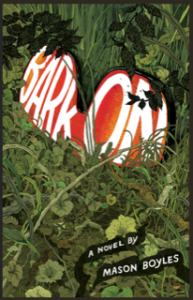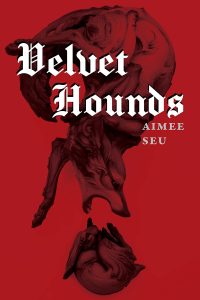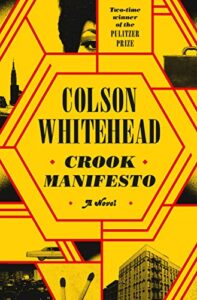Novel. 363 pgs. Driftwood Press. February 2023. 978-1-949065-18-3.
Submit, submit, submit to the cadences, the novel told me, to the neologisms that open up new perspectives on character and action, then dissolve yourself into the text: “Your sense of self has to dissipate, disappearing into the chorus of the Everywhen.” Feel yourself thread in and around and through the narrative-incantations of Ezra, Casper, Benji, Ma. Feel yourself become the order and the flux.
The night before I wrote this, I dreamt I was in the book. Casper and Ezra were there, and we were all waiting for Ma. I don’t remember if she was still at the retreat in the north, or whether she was on her way back to us, but we were trapped in Benji’s world where we swam until we drowned, cycled until our legs fell off and ran until our minds left our bodies.
I like to disperse into a novel, to move around between the sentences and take my time to merge with the ideas, to reconstruct myself as a multidimensional network of threads, a kind of mycelial web. In Bark On, a coach’s hum “broadens and reaches. It has tendrils in it – a texture and a grip.” As hyphae, I too can be everywhere, threading through letters to join them in infinite combinations and build infinite other worlds. I like to journey and become a new kind of being, as guided by a transformative novel.
Ironman triathlon, coyotes as the embodied chaos of Native American myth, and a hint of the atomic: I entered the book to explore another mind in motion. Once, on the finishing straight of a sprint triathlon, I wobbled on jellied legs, distracted by the wheezing of the athlete on my shoulder. Only when I crossed the line did I realise that person was me. I don’t know whether I’d been in my own body or not, but there were two of us and one of us was dying.
Where does the drive to seek extreme pain come from? In Mason Boyles’s shamanic world of Ironman competition, there’s a logic of convergence and emergence. First, second and third person viewpoints weave a mesh that, as it folds and unfolds, ripples with the effects of trying to escape oneself through pain. “But what’s worse than any workout,” – Ezra reflects – “is the clarity that comes without training, how his brain chafes with days when it’s not dulled by fatigue.” Is it the attachment to or avoidance of pain that drives Ma to drive Ezra to pursue elite triathlon? When “a body’s too small to hold its own feeling”, a thought-being forms, and Ma isn’t the only one subject to her emotions made conscious. Coach Benji’s belief in himself as a curse, a “Shadefoot”, drives him to compel the already-broken Casper to break Ezra, in whom they might all find fulfilment, or at least culmination.
Elite triathlon is about results, but the novel’s immersive prose-style sets up an opposition between the belief in outcomes and how the world really is. Verbs muscle-melt people and other apparent entities into processes, suggesting a kind of felt-thinking reminiscent of Leroy Little Bear’s 2004 preface to David Bohm’s On Creativity: “…many Native American languages stress morphology… process and action, mirroring the notion of constant flux.” If the discipline required to compete at elite level is a method for harnessing flux, then Ezra is on the brink of chaos. Even his home town of Kure is in continual motion. The sea devours the beach, while Ezra and Casper chase Benji’s truck along Bromine Avenue during training designed to dissolve their “cocoon”. Benji has bound the volatile Casper to Ezra, as bromine must form bonds in pairs, being too reactive to stand alone in single atoms. Casper’s earlier affair with “Adam the Atom Man” threatened to disperse his manic energy into “the butter-slide of the easy life”, from which he escaped, only to be leashed by Benji to “bark on brainlessly, [to] hold the pain.”
Through the focus on the upcoming Chapel Hill Ironman there’s a universe of chaos to contain. In Kure, where “Tootsies” Ezra and Casper train until the “hurt heatens”, the coyotes are multiplying. They appear to be hounding Benji, or perhaps he’s summoning them in his incarnation as a Shadefoot: “ ‘I have to push Tootsies ahead so I can flood into their footsteps. But I’ll drown them if they stop moving.’ ”
When Ma first appears, she feels a little like a structural bond – to explain the destructive set-up of Ezra, Casper and Benji, and to provide a female lens. Through the unfolding of her earlier travels, however, I understood the deeper weave of the integrated intelligence at work. In Peru, Ma encounters a mountain of trash dedicated to a goddess who is on the verge of waking. It seems to me that vast amounts of human energy are dedicated to containing chaos of one kind or another, yet only serve to create more. In my deranged waking visions, our frantic efforts are producing thought-beings in their decillions. Coalescing into tendrils, these manifestations “fend for [their] own food”, weaving together energy and matter to control us ever more.
The bodymind experience of Bark On helps with the agitation of the puppet-dance. Through it I can reach the “Everywhen” and rest in the ocean that connects. Ideas, characters, setting and prose form bonds with each other to stabilise the text, to build an emergent whole that bridges the ordinary world of triathlon and the non-ordinary world of Benji and his coyote curse. In Native American stories of creation, the coyote trickster figure embodies the chaos of the cosmic flux, which the human mind couldn’t otherwise absorb. “If one were to imagine,” says Little Bear, “this flux at a cosmic scale or at a mental level consisting of energy waves, one can imagine him- or herself as a surfer.” Mason Boyles is a gardener of energy, a surfer of the flux.
Bark On is available through Driftwood Press. Purchase it now through their website.
Like what you’re reading?
Get new stories or poetry sent to your inbox. Drop your email below to start >>>
OR grab a print issue
Stories, poems and essays in a beautifully designed magazine you can hold in your hands.
GO TO ISSUESNEW book release
Ghosts Caught on Film by Barrett Bowlin. Order the book of which Dan Chaon calls “a thrilling first collection that marks a beginning for a major talent.”
GET THE BOOK



